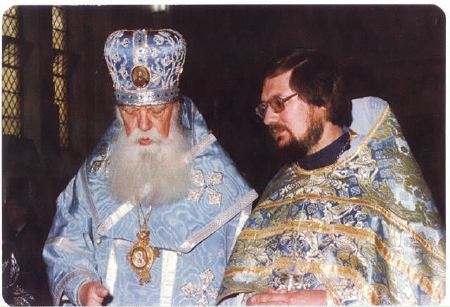NEWS
FROM THE DIOCESES |
|
DIOCESE OF SYDNEY , AUSTRALIA AND NEW ZEALAND : August 17, 2005 |
|
The 25th Anniversary of the Repose of Archbishop Feodosy (Putilin) On August 13, 1980, the pious soul of servant of God Feodosy, Archbishop of Sydney, Australia and New Zealand , departed from his long-suffering body. He was 83 years old. With his death came the end of an era; the blossoming of Russian church life in Australia was the clearest proof that the late Vladyka was a splendid administrator who knew people and was gifted in finding the right assistants for various tasks. Vladyka led the large diocese calmly and wisely, knowing the limitations and temptations of human nature. He knew that the Church is the foundation of our lives, and preserved her firmly and unwaveringly in her foundations. He was the master of his diocese, knew the minutiae of each parish and each matter. Vladyka did not spare himself, working long hours, neglecting to rest when tired... The late Vladyka's main characteristics were his simplicity and humility. He possessed a great mind and wisdom in the matters of daily life, and saw his goal clearly: to lead and guide his Russian Orthodox flock in Australia and New Zealand . Vladyka Feodosy was born in Russia to the family of a priest, and received his education in the religious schools of pre-Revolutionary Russia . After the Revolution, he wanted to become a priest, but the bishop he appealed to with this request refused him. Vladyka spoke of this in the address he read upon his installation as Bishop of Melbourne. The bishop who had refused to ordain him to the priesthood spoke words that would prove prophetic: "If it pleases the Lord to call you to His service, He will call you at the appropriate time. But do not ignore His call." This call came, and in post-War Germany , he was ordained into the deaconate and then the priesthood. As a student of Protopriest Adrian Rymarenko, who was illumined with the Divine light and later became Archbishop Andrei of Rockland, and of Archimandrite Dimitry (Biakay), Vladyka was nourished with the best of that which strengthens the soul, cleanses the heart, teaches one to love and serve ones neighbor. In 1951 he traveled to Perth , Australia , where he gave himself over to serving the Church with zeal and love for many years. Here he built the magnificent church of SS Peter and Paul. The parish loved their gregarious and good priest, who had the gift of word and the ability to console and encourage all who turned to him for guidance. But Vladyka's fate lay in archpastoral service, so in 1969 he was consecrated as a bishop. He had many conflicting thoughts and feelings, and sensed his unworthiness; he even wished to refuse consecration, but, remembering his call to service, came to understand that herein lay his future work. Vladyka was appointed Vicar Bishop and assigned to Melbourne . However, soon, in accordance with an ukase issued on November 25, 1970, Vladyka Feodosy was appointed Ruling Bishop of the Diocese of Sydney, Australia and New Zealand . This was a period of ecclesiastical conflict in Sydney . A great deal of patience, love, and mainly wisdom was invested by the late Vladyka in resolving this difficulty. Having no knowledge of the local situation, not knowing the people and lacking even a single acquaintance in his new city , Vladyka took on a heavy cross in attempting to resolve the problems and achieve a peaceful outcome of the conflict. With God's help, Vladyka was able to bring his seemingly hopeless matter to the desired result. The Cathedral of SS Peter and Paul in Sydney was returned to the bosom of the Russian Church Abroad, and the large parish returned to its proper path. This was 1977, and Vladyka Feodosy sacrificed a great deal of health, energy and effort to this matter, which lasted for years, and had brought with it unpleasantness, disintegration and enmity among the Russian people. The return of the Cathedral and its parish, whose Rector was the late Vladyka himself, might be considered his main achievement, but this is not quite so. The main driving force was in the man himself, who gave his all for service to God, and he was able to make peace and relieve the pain of insult and strife. He was able to understand each person and forgive those who had gone astray. People understood that their archpastor, their father, their leader, pursued only one goal: to create a strong diocese, unify all its spiritual forces to preserve the Russian Church in Australia . The life of the Diocese of Australia and New Zealand is multi-faceted and variegated. It was founded by Archbishop Feodor and Archbishop Savva, and finally brought into fullness by Archbishop Feodosy. By 1980, the Diocese had a string of parish schools, a hospital for the chronically ill, a nursing home, the Russian Benevolent Society and other charitable organizations, and its own publishing arm which printed the diocesan journal. The scope of a person's achievements is not only determined by what he had accomplished himself, but also how he led his life, what meaning his person had for those around him. The long funerary service at the Sydney Cathedral showed what the late bishop meant to his flock. Bishop Paul (Pavlov) of Stuttgart , who later took over the Australian see himself, performed the service. The enormous gathering of worshipers filled the Cathedral and its churchyard. The sorrow of parting with their beloved archpastor filled the hearts of everyone in attendance, and tears flowed freely. In accordance with the wishes of the late Vladyka and of his family, his body was buried in the church cemetery in Perth . |
